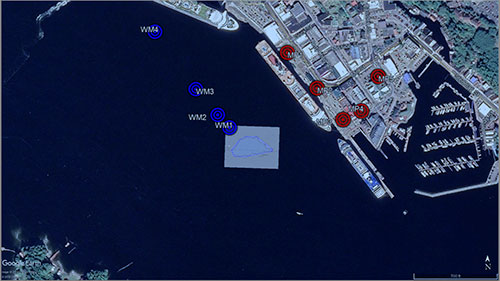
Removal of Berth II Rock Pinnacle
December 17, 2019
Similar drilling and blasting techniques to what would be used for quarry and construction rock excavation will be used, with the main difference being that all work will be performed underwater from a barge. Excavator-mounted rock drills will be used to drill the blast holes into the rock at the bottom of the channel, and explosives products suitable for underwater blasting are installed in these holes. A typical blast will comprise dozens of holes, each detonating a few milliseconds from the previous hole to minimize the effect of the blast on the public, nearby marine wildlife, and structures and vessels in the vicinity. A number of carefully designed and permitted confined blasts will be required to break up the rock. The confined nature of the blasts will assure that energy is directed into the immediate rock pinnacle rather than the adjacent area or water column. Each blast will sound similar to faraway thunder and the entire event will be over in less than one second. People on land may feel ground vibrations transmitted from the blast, but the anticipated very low intensity vibrations will be well below any level of concern for nearby structures. Instruments installed shore side (five locations) will be monitoring these blasting vibrations to ensure the safety of dock-side structures and nearby commercial and residential structures. In-water pressure measurements from the blasts will also be taken (four locations), to ensure the protection of marine wildlife and nearby vessels. Independent 3rd party specialist firms are providing oversight on all these measurements. In addition, a team of marine biologists will be deployed to assure the safety of various species of marine mammals and fish which may be present in the area. The initial phase of drilling and blasting is planned to start on Tuesday December 17, 2019 and will be completed by Christmas. The team is returning after New Year’s to complete the blasting and affiliated dredge material removal during January and early February of 2020. Blasting is expected to take place daily (one blast per day), 7 days per week, during daylight hours. The contractor will broadcast warnings via channels 13 and 16 VHF 2 hours, 1 hour, 30 minutes and 15 minutes prior to the daily blast. At 5 minutes pre-blast, a long wailing siren will sound, and at 1 minute a series of short yelping sirens will sound. A 1,500-foot blasting safety zone will be enforced from 30 minutes before the blast until approximately 5 minutes after the blast, at which time the “all clear” will be sounded (long continuous siren sound).
Edited By Mary Kauffman, SitNews
Source of News:
|
||||
